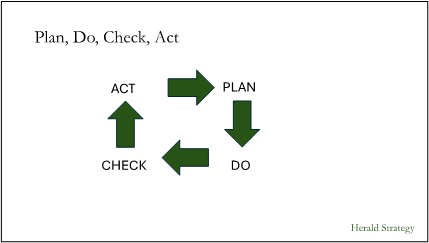
With its roots in manufacturing, continuous improvement is a method that strives to locate opportunities for ensuring efficiency, continuously.
This involves the assessment of current processes, products and services to ensure that output is maximized, and waste is minimized.
So, what does this manufacturing led idea, associated with Toyota and known as kaizen, have to do with leadership?
Founders and CEOs aspire to be as effective as possible in the complex and varied situations that they encounter. You are responsible for engaging people, implementing policies, making decisions and drive initiatives that advance the company goals.
I have been a CEO for decades and lived this reality too. For me, the notion of continuous improvement is fundamental, or perhaps better put as the idea that the leader is on a personal journey and should always be finding better ways of doing things. Often successful Founders and CEOs who want to build on-going improvement into their company culture live this idea themselves. The reality is that your example and prioritization will signal to your people the value that you place on getting better.
The Shewhart cycle offers an effective implementation model
The Shewhart cycle, which is sometimes known as the plan, do, check, act methodology (PDCA), is a four-step approach for implementing continuous improvement. It involves consideration of the current paradigm, systematic small-scale testing of possible solutions, assessing the results, and then the scaled implementation of the solutions that have shown to work.

The principles of this approach also work well for Founders and CEOs looking to improve their personal effectiveness.
Sophisticated leaders develop by understanding themselves
The personal equivalent of the Shewhart cycle is to start by understanding your strengths to exploit, and potential challenges to address, as the first step in developing and refining leadership skills. Each leader should then reflect on these learnings and build a specific action plan pertinent to you, your team and your circumstances. Every leader is unique and has their own special qualities and characteristics.
This unique situation demands tailored measurement to effectively achieve goals. The ideal method is to consider each selected action and define how progress can be measured. These measurement criteria become the basis of bespoke performance improvement; each targeted area measured on an on-going basis using your personal feedback loop.
So, where is a good place to start in understanding personal strengths, characteristics and challenges?
Fearless leaders are stimulated by the catalyst of an Assessment Report
360’ stakeholder interviews are an invaluable tool providing evidence-based input into this reflection process. That said, these interviews need focus and shape, so the completion of a personal Assessment exercise is often the most useful way to begin.
Personal Assessments are a very effective mechanism to gather data.
There are numerous personal assessment tools like Profiles XT, Hogan and Myers Briggs. These tools are designed to help individuals understand their own unique traits and tendencies.
The process is the same for each tool. The leader will complete a one-off exercise where you answer a series of questions or prompts, typically online, which explore different aspects of your personality, skills and behaviors. This usually takes a short amount of time.
The outputs are also similar for each tool. The results are presented in a detailed report highlighting strengths, tendencies and insights into your leadership style. These tools provide an evidence-based data set that facilitates the creation of a clear, actionable roadmap for personal and professional growth. The outputs are a solid start point for a discussion about the areas that you want to work on to optimize your leadership performance in your situation. This process stimulates self-reflection and is the springboard to creating your bespoke measurable action plan.
The validated and reliable Profile XT Select Assessment from Profiles International is an ideal tool to do this and help to fine tune your leadership. It is my preferred tool to illuminate your thinking skills, your approach to confronting challenges, your tendencies and behaviors.
Top reason to use the Profile XT Select approach
The tool is a self-completion survey-based exercise. The results provide a total person overview of your characteristics and how they manifest in your leadership style. The outputs are insightful and stimulating they cover Thinking Style, Behavioral Traits and Interests.
Clearly leadership is a complex role and of course your circumstances are unique with unique colleagues, opportunities, challenges and resources.
That said, data on each of these three areas will stimulate reflection and prompt learning:
Thinking Styles
looks at the ability to process information. It includes problem solving, communication, interaction and learning skills
Behavior Traits
are commonly observed actions that help define who you are
Interests
may predict your motivation and potential satisfaction with certain types of role
I find that the Behavior Traits data is particularly valuable.
The 9 measured traits cover a broad spectrum to reveal how you “show up” and as such they provide a rich starting point to assess strengths and areas that you may want to develop. Each trait is worth reflection to understand how the tendency may help you achieve a particular goal or be an obstacle.
For example, Pace measures your tendency to restlessness and drive and the degree to which you operate efficiently with time utilization. Is your natural Pace tending towards Steady where you are patient and prefer to think things through before acting? Or are you more Urgent where you want to multitask and become frustrated when results do not come quickly?
There is no right or wrong here, it is simply a tendency which will affect how you get things done and how your colleagues find working with you.
Consideration of the full nine traits gives a total person view on how you show up:
- Pace, overall rate of task completion
- Assertiveness, expression of opinions and need for control
- Sociability, desire for interaction with others
- Conformity, attitudes on policies and supervision
- Outlook, anticipation of outcomes and motives
- Decisiveness, use of speed and caution to make decisions
- Accommodating, inclination to tend to others needs and ideas
- Independence, level of preference for instruction and guidance
- Judgement, basis for forming opinions and making decisions
For me, understanding that these tendencies across the 9 Behavior Traits have consequences is key. They impact on your performance; they signal what you see as the right behaviors and effect how your colleagues see you and the company. Understand these behaviors, reflect on them and build action plans that will optimize the effectiveness of how you operate.
Conclusion: the kaizen path is the way to improved performance
Just as the idea of Continuous Improvement can create increased effectiveness in manufacturing, it can also be applied to the development of leadership effectiveness. Systematically understanding who you are as a leader and then taking the steps to use your strengths and iterate on other areas will optimize your performance.
Successful Leaders
At Herald Strategy we believe that embracing the idea of continuous personal improvement will help you implement action plans that lead to measurable results.




